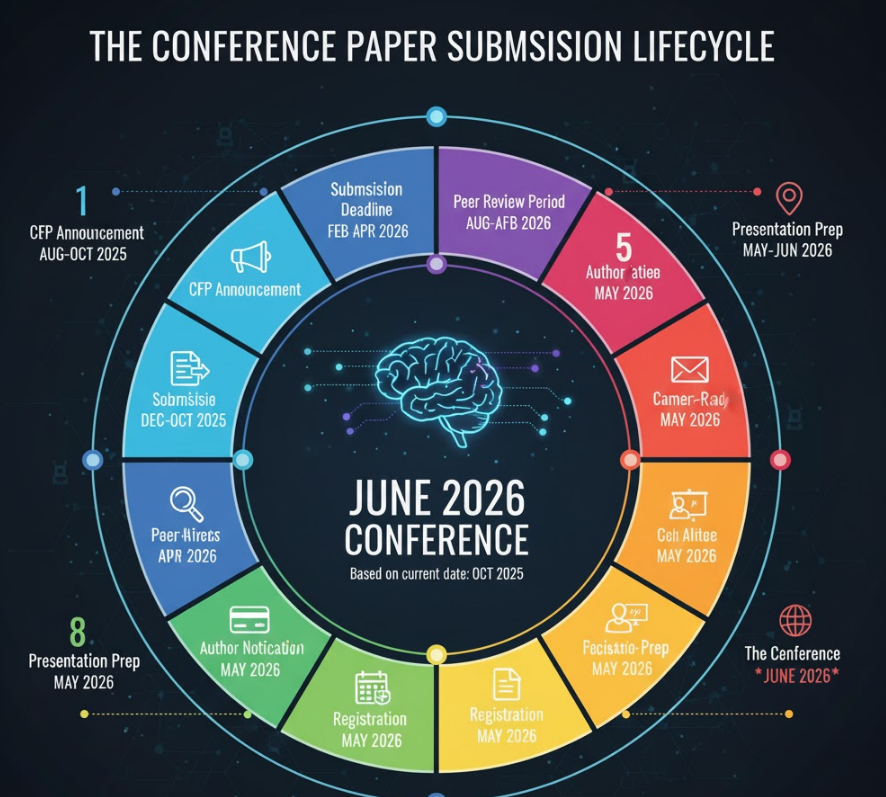For any researcher, submitting a paper to an academic conference is a major milestone. But the journey from a finished manuscript to a final presentation is a long one, often spanning the better part of a year. Understanding this submission lifecycle, is essential for effective planning and avoiding last-minute stress.
This guide provides a detailed breakdown of each phase in the conference submission process, complete with typical timelines, to help you schedule your research and writing.

The entire process, from the first announcement to the day of the conference, can be divided into several distinct stages:
Call for Papers (CFP) Announcement
Paper Preparation & Submission Deadline
Peer Review Period
Author Notification (The Decision)
Camera-Ready Version Submission
Conference Registration Deadline
Presentation Preparation
The Conference Event
Let's use a hypothetical but realistic example: planning for a conference in June 2026. (Based on the current date of October 9, 2025)
What it is: This is the official announcement from the conference organizers. The CFP outlines the conference theme, topics of interest, important dates (submission deadline, notification date, etc.), and submission guidelines.
Typical Timing: 8 to 12 months before the conference.
Example Timeline: For a June 2026 conference, the CFP is typically released between June and October 2025. This is the signal to start aligning your research and planning your paper.
What it is: This is the period when you write your paper, conduct experiments, and prepare it for submission according to the conference's formatting rules. The submission deadline is the final, hard cutoff for uploading your manuscript to the conference portal.
Typical Timing: The deadline is usually 4 to 6 months before the conference.
Example Timeline: For our June 2026 conference, the paper submission deadline would likely fall between December 2025 and February 2026.
What it is: Once submitted, your paper enters the "black box" of peer review. The program committee assigns your paper to several expert reviewers in your field who will meticulously critique its originality, methodology, and impact.
Typical Timing: This is highly variable but generally takes 6 to 12 weeks.
Example Timeline: After a January 2026 submission, the review period would last from February through March or early April 2026.
What it is: This is the day you receive the crucial email with the committee's decision: Accept, Minor Revision, Major Revision, or Reject.
Typical Timing: 2 to 3 months before the conference.
Example Timeline: For a June 2026 conference, you would likely receive the notification in mid-to-late April 2026.
What it is: If your paper is accepted (often with revisions), you must prepare the final version for publication. This involves addressing the reviewer comments, perfecting the formatting, and submitting the final manuscript. This is called the "camera-ready" copy.
Typical Timing: The deadline is usually 2 to 4 weeks after the notification date.
Example Timeline: After an April notification, the camera-ready version would be due in early to mid-May 2026.
What it is: To have your paper included in the proceedings, at least one author must pay and register for the conference. This deadline is often the same as or slightly after the camera-ready deadline.
Typical Timing: 1.5 to 2.5 months before the conference.
Example Timeline: The author registration deadline would also be around mid-May 2026, often coinciding with the end of the "Early Bird Registration" period.
What it is: The final phase where you create your slides for an oral presentation or design your poster. This involves synthesizing your paper into a clear, engaging format and practicing your delivery.
Typical Timing: The weeks leading up to the conference.
Example Timeline: Late May to early June 2026.
What it is: The culmination of your work! You travel to the conference, present your paper, network with peers, and learn about the latest research in your field.
Example Timeline: June 2026.
As the timeline shows, the conference submission lifecycle is a lengthy process that requires planning well in advance. From the moment the Call for Papers is released, there is often a full 8-12 month journey to the final presentation. By understanding this cycle and working backward from the conference dates, you can effectively schedule your research, writing, and administrative tasks, ensuring a smooth and successful publication experience.